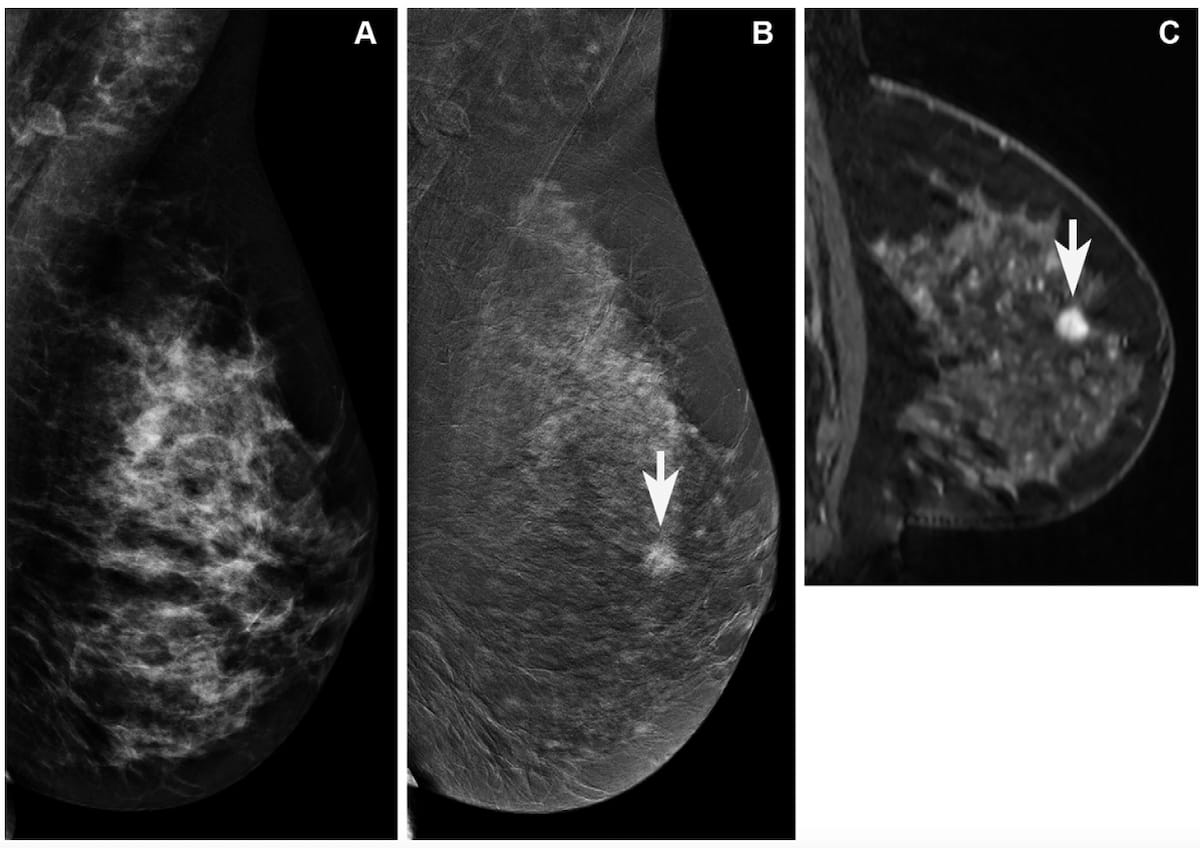Can contrast-enhanced mammography (CEM) offer similar breast cancer detection as magnetic resonance imaging (MRI)?
For a new study, recently published in Radiology, researchers compared conventional mammography, CEM, breast MRI and abbreviated breast MRI (AB MRI) in a review of case sets for 132 women (mean age of 54) who had screening-detected abnormalities. The case sets included 44 cases of malignancy and 74 cases with benign results, according to the study.
The researchers found that CEM offered superior breast cancer detection with a 91 percent area under the receiver operating characteristic curve (AUC) in comparison to conventional mammography (79 percent AUC). Contrast-enhanced mammography also demonstrated equivalent detection to breast MRI (89 percent AUC) and AB MRI (91 percent AUC).
“Although this trial was a reader study rather than a large-scale prospective clinical trial, the results are a key step toward the replacement of screening breast MRI, whether a full or abbreviated MRI protocol, with CEM,” wrote lead study author Jordana Phillips, M.D., who is affiliated with the Department of Radiology at the Beth Israel Deaconess Medical Center in Boston, and colleagues.
“Replacing MRI with CEM may have the greatest value in individuals at intermediate to high risk of breast cancer who currently are not benefiting from supplemental MRI screening despite national recommendations to undergo it.”
For women with dense breast tissue, the study authors noted that CEM offered a 15 percent higher AUC in comparison to conventional mammography (89 percent vs. 74 percent) and equivalent breast cancer detection to breast MRI (89 percent AUC) and AB MRI (87 percent AUC).
Three Key Takeaways
- Contrast-enhanced mammography (CEM) outperforms conventional mammography. The study suggests that CEM offers superior breast cancer detection compared to conventional mammography. CEM demonstrated a 91 percent area under the receiver operating characteristic curve (AUC), whereas conventional mammography had a lower AUC of 79 percent. This highlights the potential of CEM as an advanced imaging technique for breast cancer screening.
- Similar breast cancer detection to breast MRI. The research indicates that CEM shows comparable breast cancer detection to breast MRI and abbreviated breast MRI (AB MRI). CEM had an AUC of 89 percent, while breast MRI and AB MRI had AUCs of 89 percent and 91 percent, respectively. This suggests that CEM could be a viable alternative to MRI, particularly in cases where MRI may not be feasible or accessible.
- Potential application in women with dense breast tissue. For women with dense breast tissue, CEM demonstrated a 15 percent higher AUC compared to conventional mammography (89 percent vs. 74 percent). Additionally, CEM showed equivalent breast cancer detection to breast MRI and AB MRI in this specific subgroup. This suggests that CEM may be particularly valuable for women with dense breasts, a population that often poses challenges for traditional mammography.
The researchers also pointed out that CEM offered non-inferior results to breast MRI and AB MRI regardless of low or high background parenchymal enhancement (BPE) findings.
The study authors suggested that the continued evolution of artificial intelligence (AI) may enhance the capabilities of CEM.
“Additional research, more tailored to specific risk factors or tissue density and using artificial intelligence tools, can further refine the best use for this imaging tool,” noted Phillips and colleagues.
(Editor’s note: For related content, see “Can DWI MRI Offer a Non-Viable Contrast Alternative for Breast Cancer Assessment?,” “Study Reveals Tradeoffs Between Contrast-Enhanced Mammography and MRI for Supplemental Screening” and “Ultravist Becomes First FDA-Approved Contrast Agent for Contrast-Enhanced Mammography.”)
In regard to study limitations, the authors acknowledged a highly enriched cohort with women who had abnormal findings at screening exams. The researchers also noted that subanalysis findings on tissue density and background parenchymal enhancement were derived from the interpretation of one radiologist.











